steering wheel BMW 525i 1998 E39 User Guide
[x] Cancel search | Manufacturer: BMW, Model Year: 1998, Model line: 525i, Model: BMW 525i 1998 E39Pages: 1002
Page 622 of 1002

Downloaded from www.Manualslib.com manuals search engine
[~us~ension, Steering and Brakes - General
This section of the manual covers front and rear suspension,
braking and steering systems, and contains wheel, tire and
wheel alignment information and specifications. Also covered
here are the integrated braking and suspension systems in-
cluding
antilock braking (ABS), traction control (ASCIDSC),
and electronic height control (EHC).
Vehicle ride height information is at the end of this repair
group. Alignment information is in
320 Steering and Wheel
Alignment.
Aluminum suspension components
In order to reduce vehicle weight, aluminum suspension com-
ponents are used in some models. A test with a magnet will
easily reveal the metal used. If working with aluminum com-
ponents, be sure to read and follow the cautions below.
CAUTION-
* Due to the chemical and corrosion characteristics of alumi-
num, do not bring into contact with battery acid.
Do not use wire brushes with brass or iron bristles.
Only use brushes with stainless steel bristles.
Do not expose to flying sparks from
grinding/cutting op-
erations.
Do not subject to steel welding splashes.
Do not expose to temperatures over
80°C (176"F),
even for short periods. Temperatures in painting facili-
ties are not a problem.
The E39 front suspension subframe is used as a rigid mount-
ing platform for the front suspension arms, stabilizer bar and
steering gear.
The suspension arms, known as the lower control arms and
the tension struts (thrust arms), are connected to the
sub-
frame through rubber bushings. The arms are connected to
the steering
knucltles in a double pivot configuration.
Each front strut assembly includes a tubular strut and a coil
spring. The upper strut mount includes a bearing. The lower
end of each strut housing is fitted to the steering knuckle. The
integral wheel bearing and hub are bolted to the steering
Iknucltle.
6-cylinder and V-8 models use different steering systems and
other front suspension components.
Page 625 of 1002
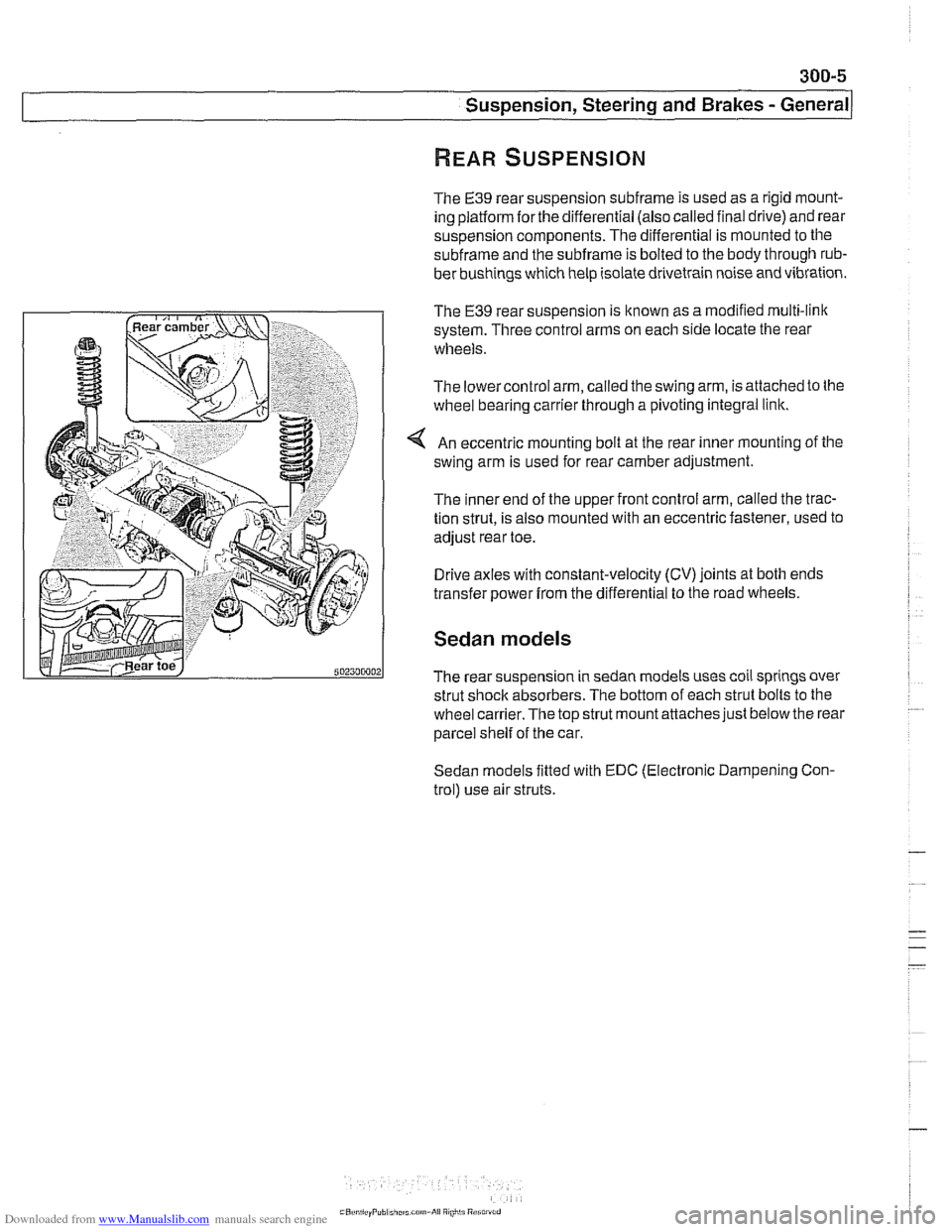
Downloaded from www.Manualslib.com manuals search engine
300-5
Suspension, Steering and Brakes - ~enerall
The E39 rear suspension subframe is used as a rigid mount-
ing platform
forthe differential (also called final drive) and rear
suspension components. The differential is mounted to the
subframe and the subframe is bolted to the body through rub-
ber bushings which help isolate drivetrain noise and vibration.
The
€39 rear suspension is known as a modified multi-link
system. Three control arms on each side locate the rear
wheels.
The lowercontrol arm, called the swing arm, is attached to the
wheel bearing carrier through a pivoting integral link.
An eccentric mounting bolt at the rear inner mounting of the
swing arm is used for rear camber adjustment.
The inner end of the upper front control arm, called the trac-
tion strut, is also mounted with an eccentric fastener, used to
adjust rear toe.
Drive axles with constant-velocity (CV) joints at both ends
transfer power
from the differential to the road wheels.
Sedan models
The rear suspension in sedan models uses coil springs over
strut shock absorbers. The bottom of each strut bolts to the
wheel
carrier.The top strut mount attaches just below the rear
parcel shelf of the car.
Sedan models fitted with EDC (Electronic Dampening Con-
trol) use air struts.
Page 626 of 1002
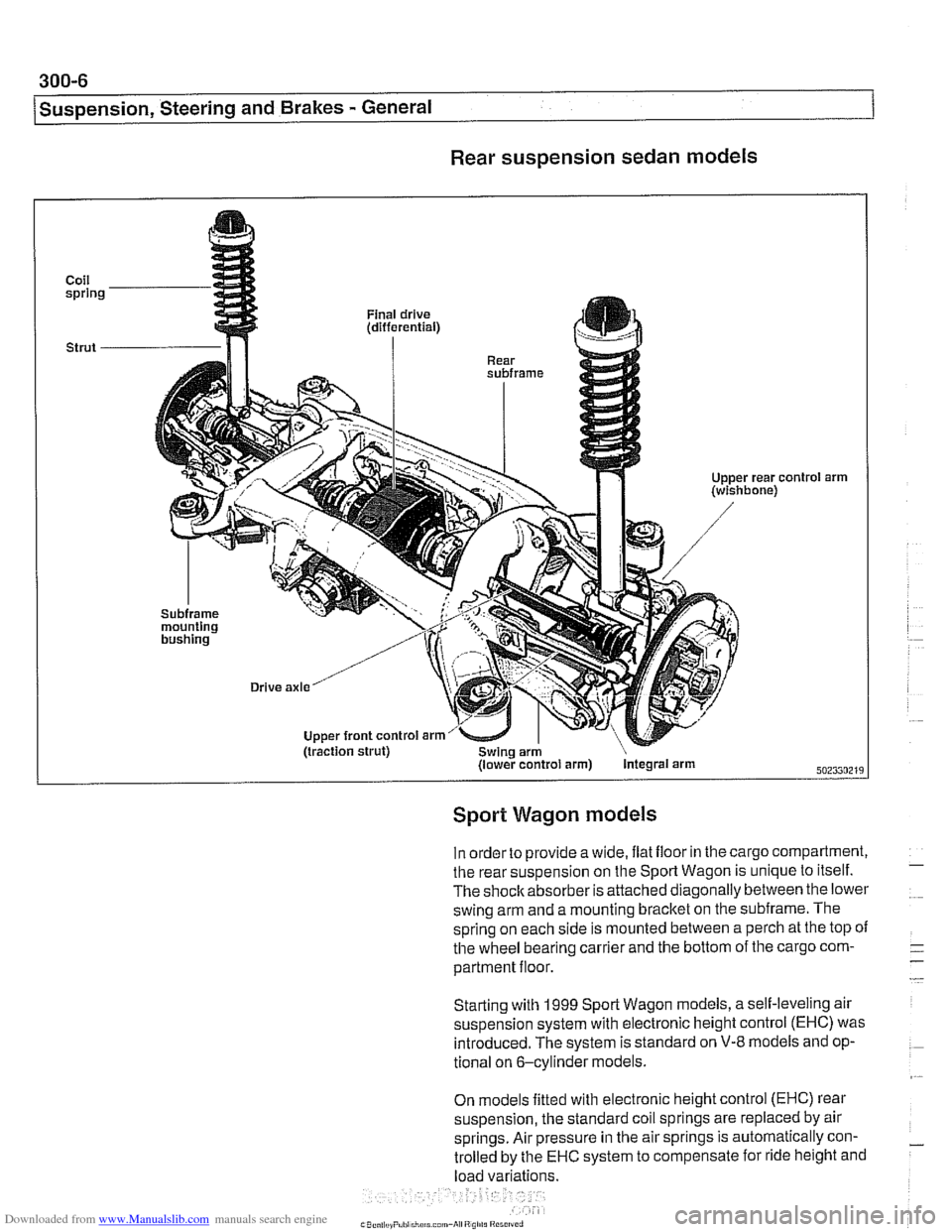
Downloaded from www.Manualslib.com manuals search engine
300-6
/Suspension, Steering and Brakes - General
Rear suspension sedan models
Coil spring
Strut
-
'01 arm
Sport Wagon models
In order to provide a wide, ilat iloor in the cargo compartment,
the rear suspension on the Sport Wagon is unique to itself.
The shoclcabsorber is attached diagonally between the lower
swing arm and a mounting bracket on the subframe. The
spring on each side is mounted between a perch at the top
oi
the wheel bearing carrier and the bottom of the cargo com-
partment floor.
Starting with
1999 Sporl Wagon models, a self-leveling air
suspension system with electronic height control (EHC) was introduced. The system is standard on
V-8 models and op-
tional on 6-cylinder models.
On models fitted with electronic height control (EHC) rear
suspension, the standard coil springs are replaced by air
springs. Air pressure in the air springs is automatically con-
trolled by the
EHC system to compensate for ride height and
load variations.
Page 628 of 1002
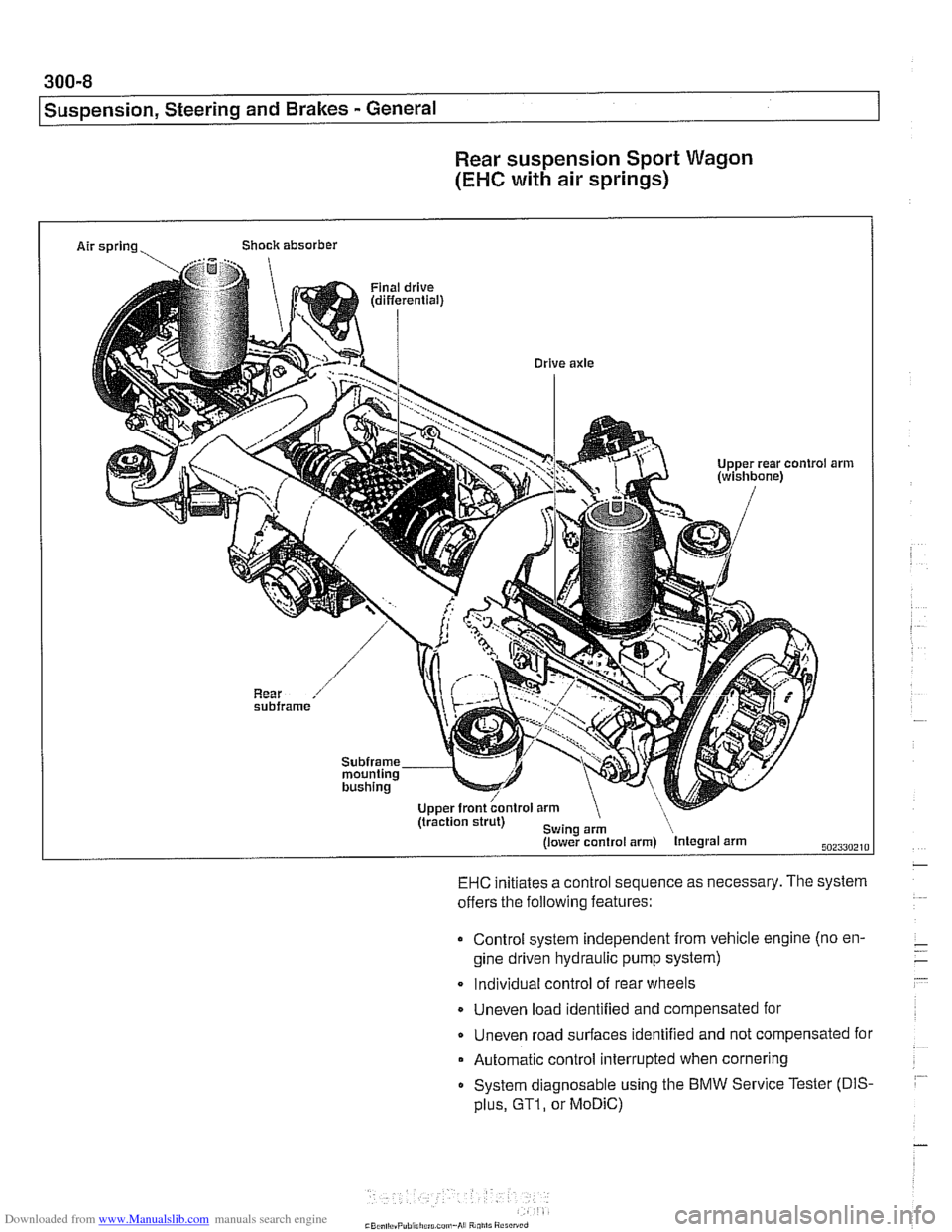
Downloaded from www.Manualslib.com manuals search engine
300-8
Suspension, Steering and Brakes - General
Rear suspension Sport Wagon
(EHC with air springs)
Air sprIn9 Shock absorber I
(tiaction strut) arA
(lower control arm) Integral arm 502330210
EHC initiates a control sequence as necessary. The system
offers the following features:
Control system independent from vehicle engine (no en-
gine driven hydraulic pump system)
Individual control of rear wheels
Uneven load identified and compensated for
Uneven road surfaces identified and not compensated for
Automatic control interrupted when cornering
System diagnosable using the
BMW Service Tester (DIS-
plus, GTI, or MoDiC)
Page 630 of 1002
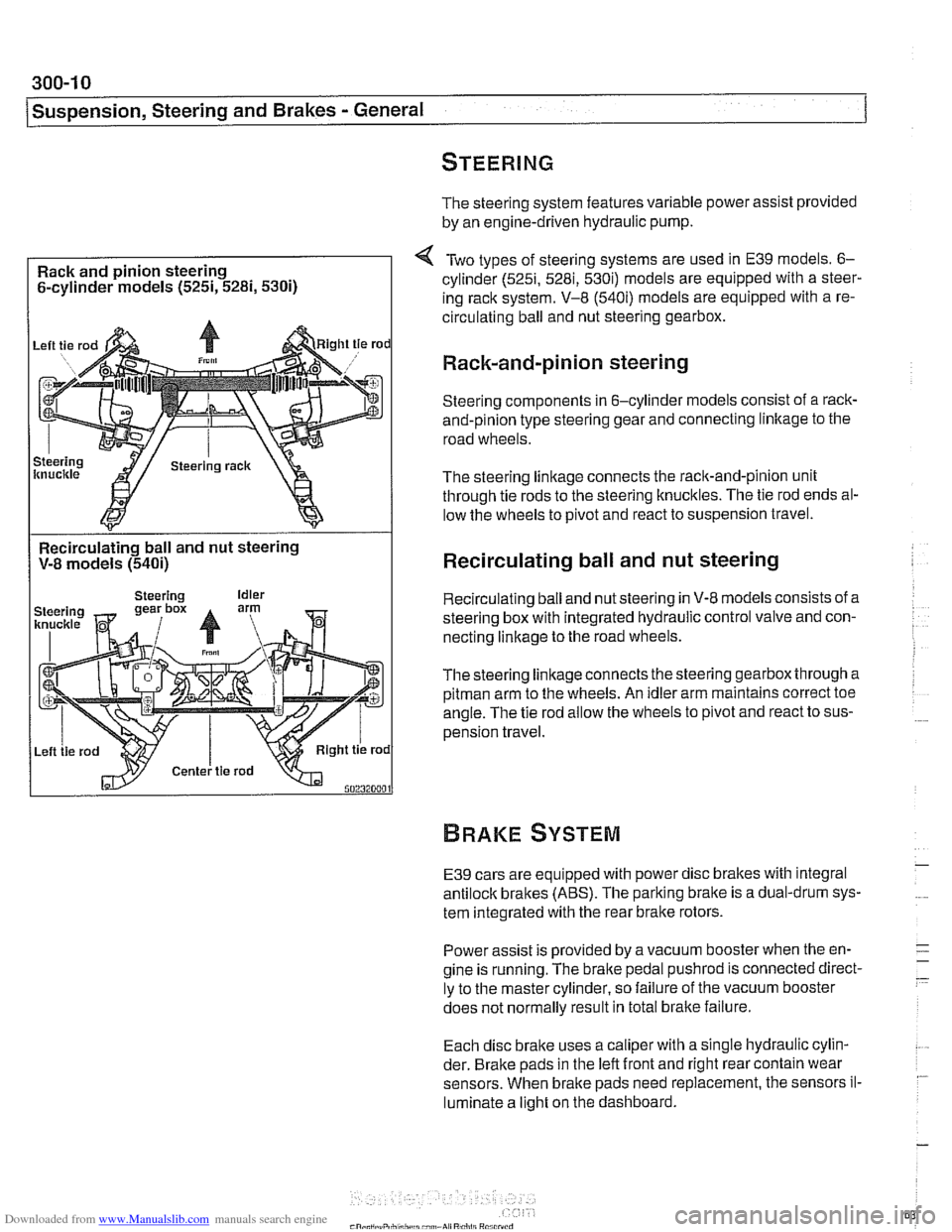
Downloaded from www.Manualslib.com manuals search engine
300-1 0
/Suspension, Steering and Brakes - General
The steering system features variable power assist provided
by an engine-driven hydraulic pump.
Rack and pinion steering
6-cylinder models
(525i, 5281, 5300
Two types of steering systems are used in E39 models. 6-
cylinder (525i, 5281, 530i) models are equipped with a steer-
ing rack system. V-8
(540i) models are equipped with a re-
circulating ball and nut steering gearbox.
Rack-and-pinion steering
Steering components in 6-cylinder models consist of a rack-
and-pinion type steering gear and connecting linltage to the
road wheels.
The steering linkage connects the rack-and-pinion unit
through tie rods to the steering knucltles. The tie rod ends al-
low the wheels to pivot and react to suspension travel.
Recirculating ball and nut steering
V-8 models
(540i)
I
Recirculating ball and nut steering
Recirculating ball and nut steering in V-8 models consists of a
steering box with integrated hydraulic control valve and con-
necting linkage to the road wheels.
Thesteering linkageconnects the steering gearbox through a
pitman arm to the wheels. An idler arm maintains correct toe
angle. The tie rod allow the wheels to pivot and react to sus-
pension travel.
E39 cars are equipped with power disc brakes with integral
antilock brakes (ABS). The parking bralte is a dual-drum sys-
tem integrated with the rear brake rotors.
Power assist is provided by a vacuum booster when the en-
gine is running. The brake pedal
pushrod is connected direct-
ly to the master cylinder, so failure of the vacuum booster
does not normally result in total
bralte failure.
Each disc bralte uses a caliper with a single hydraulic cylin-
der. Brake pads in the left front and right rear contain wear
sensors. When brake pads need replacement, the sensors il-
luminate a light on the dashboard.
Page 631 of 1002
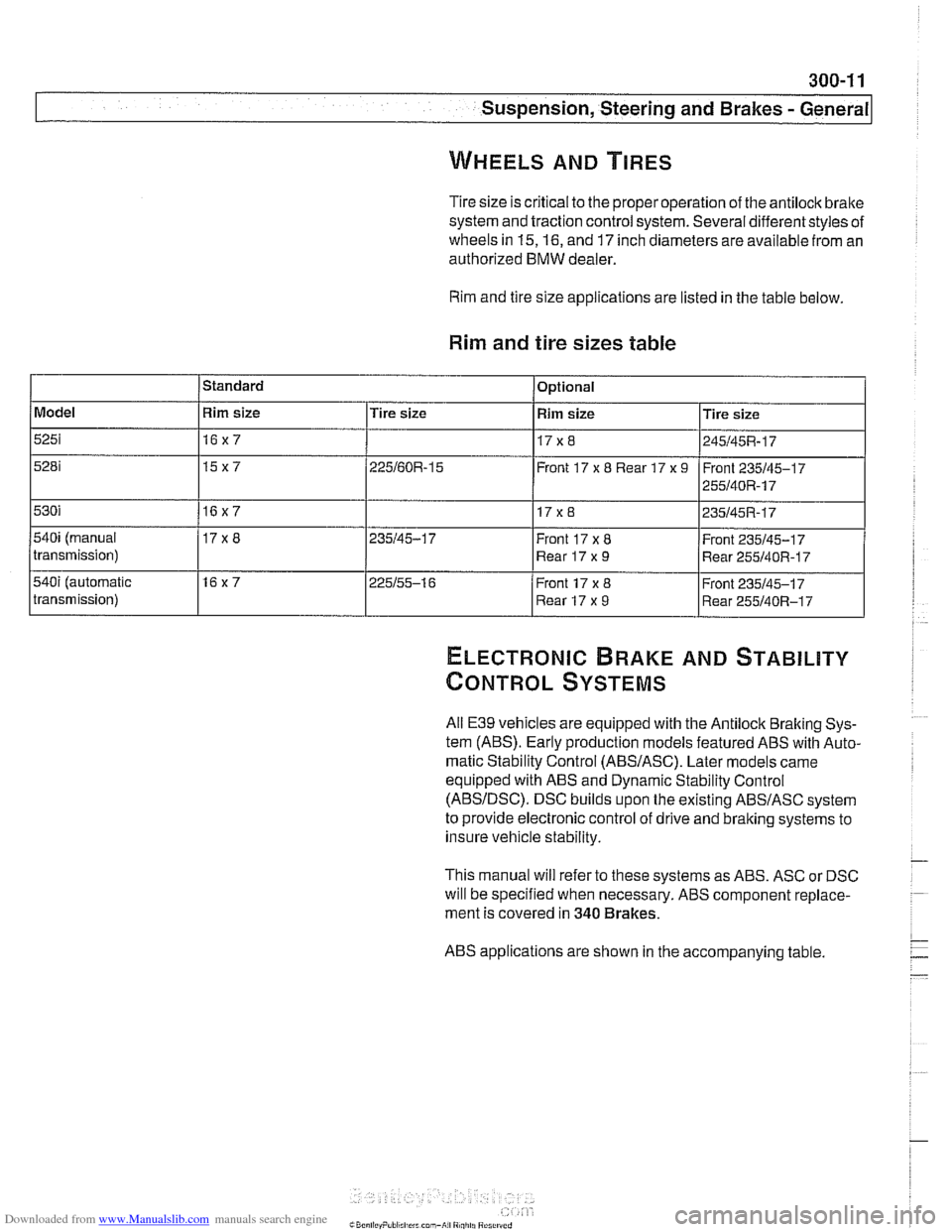
Downloaded from www.Manualslib.com manuals search engine
Suspension, Steering and Brakes - General
WHEELS AND TIRES
Tire size is critical to the properoperation of the antilock brake
system and traction control system. Several differentstyles of
wheels in
15,16, and 17 inch diameters are available from an
authorized BMW dealer.
Rim and tire size applications are listed in the table below.
Rim and tire sizes table
ELECTRONIC BRAKE AND STABILITY
CONTROL SYSTEMS
Model
5251
5281
530i
540i (manual
transmission)
540i (automatic
transmission)
All
E39 vehicles are equipped with the Antilock Braking Sys-
tem
(ABS). Early production models featured ABS with Auto-
matic Stability
control (ABSIASC). Later models came
equipped with ABS and Dynamic Stability Control
(ABSIDSC). DSC builds upon the existing ABSIASC system
to provide electronic control of drive and braking systems to
insure vehicle stability.
This manual will refer to these systems as ABS. ASC or DSC
will be specified when necessary. ABS component replace-
ment is covered in
340 Brakes.
Standard
ABS applications are shown in the accompanying table
Rim size
16x7
15x7
16x7
17x8
16x7 Optional
Tire size
225160R-15
235145-1 7
225155-1 6
Rim size
17x8
Front 17
x 8 Rear 17 x 9
17 x 8
Front 17x8
Rear 17x9
Front 17 x 8
Rear 17 x 9 Tire
size
245145R-17
Front 235145-1 7
255140R-17
235145R-17
Front 235145-1 7
Rear
255140R-17
Front 235145-17
Rear 255140R-17
Page 632 of 1002
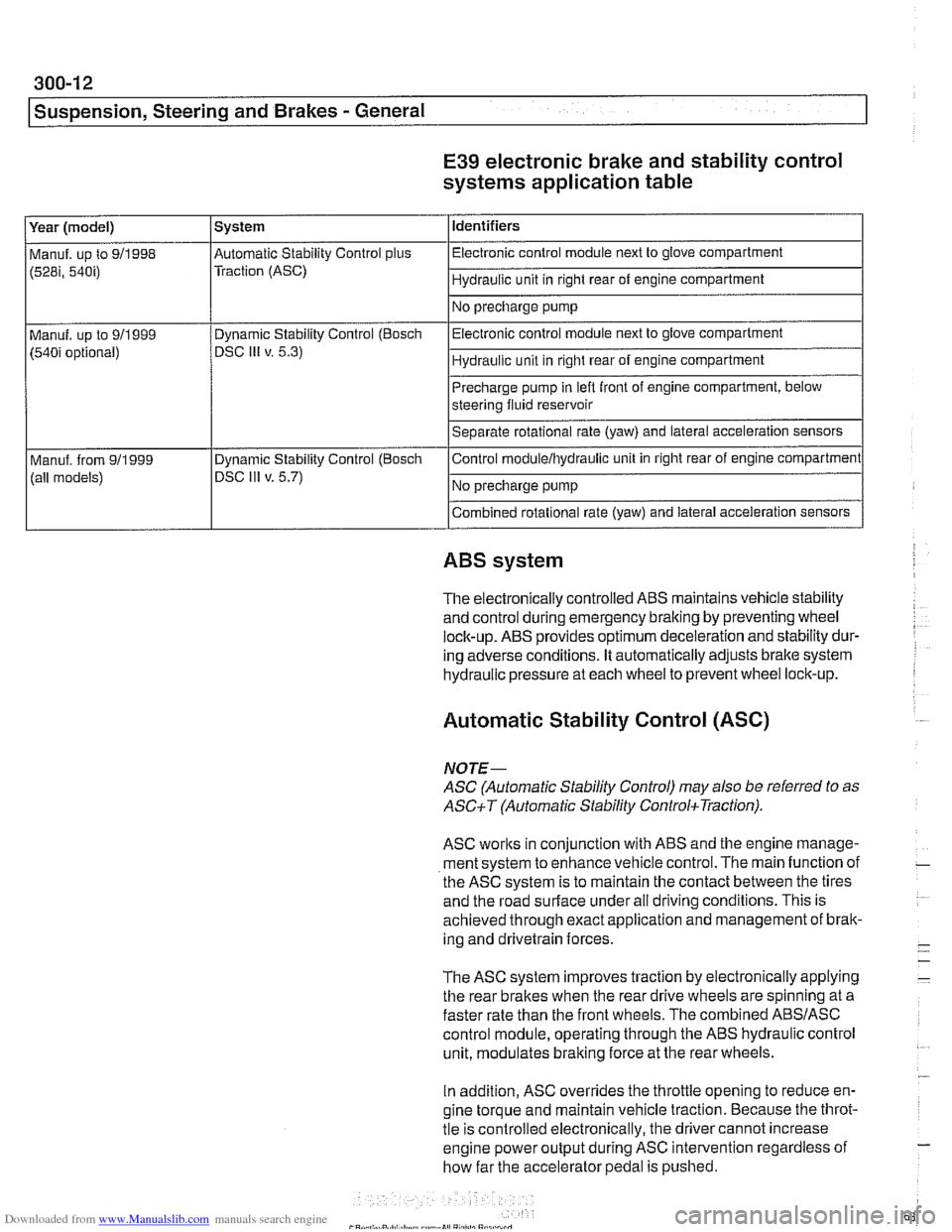
Downloaded from www.Manualslib.com manuals search engine
300-1 2
I Sus~ension, Steerincl and Brakes - General
E39 electronic brake and stability control
systems application table
(528i, 54bi) Traction (ASC) I Hydraulic unit in right rear of engine compartment 1
Identifiers
Year (model)
I No precharge pump 1
Manuf. up to 911998 l~utomatic Stability Control plus I Electronic control module next to glove compartment
System
Precharge pump in
lefl front of engine compartment, below
steering fluid reservoir
Separate rotational rate (yaw) and lateral acceleration sensors
I I
Combined rotational rate (yaw) and lateral acceleration sensors
Electronic control
module next to glove compartment
Hydraulic unit in right rear of engine compartment
Manuf. up to 911999
(540i optional)
I I
ABS system
Dynamic Stability Control (Bosch
DSC
Ill v. 5.3)
The electronically controlled
ABS maintains vehicle stability
and control during emergency braking by preventing wheel
lock-up.
ABS provides optimum deceleration and stability dur-
ing adverse conditions. It automatically adjusts brake system
hydraulic pressure at each wheel to prevent wheel lock-up.
Control
moduleihydraulic unit
in right rear of engine compartment
No precharge pump
Manuf. from
911999
(all models)
Automatic Stability Control (ASC)
Dynamic Stability Control (Boscli
DSC Ill v. 5.7)
NOJE-
ASC (Automatic Stability Control) may also be referred to as
ASCiT (Automatic Stability ControkTraction).
ASC works in conjunction with ABS and the engine manage-
ment system to enhance vehicle control. The main function of
the
ASC system is to maintain the contact between the tires
and the road surface under all driving conditions. This is
achieved through exact application and management of brak-
ing and drivetrain forces.
The
ASC system improves traction by electronically applying
the rear brakes when the rear drive wheels are spinning at a
faster rate than the front wheels. The combined
ABSIASC
control module, operating through the ABS hydraulic control
unit, modulates braking force at the rear wheels.
In addition,
ASC overrides the throttle opening to reduce en-
gine torque and maintain vehicle traction. Because the throt-
tle is controlled electronically, the driver cannot increase
engine power output during
ASC intervention regardless of
how far the accelerator pedal is pushed.
Page 633 of 1002
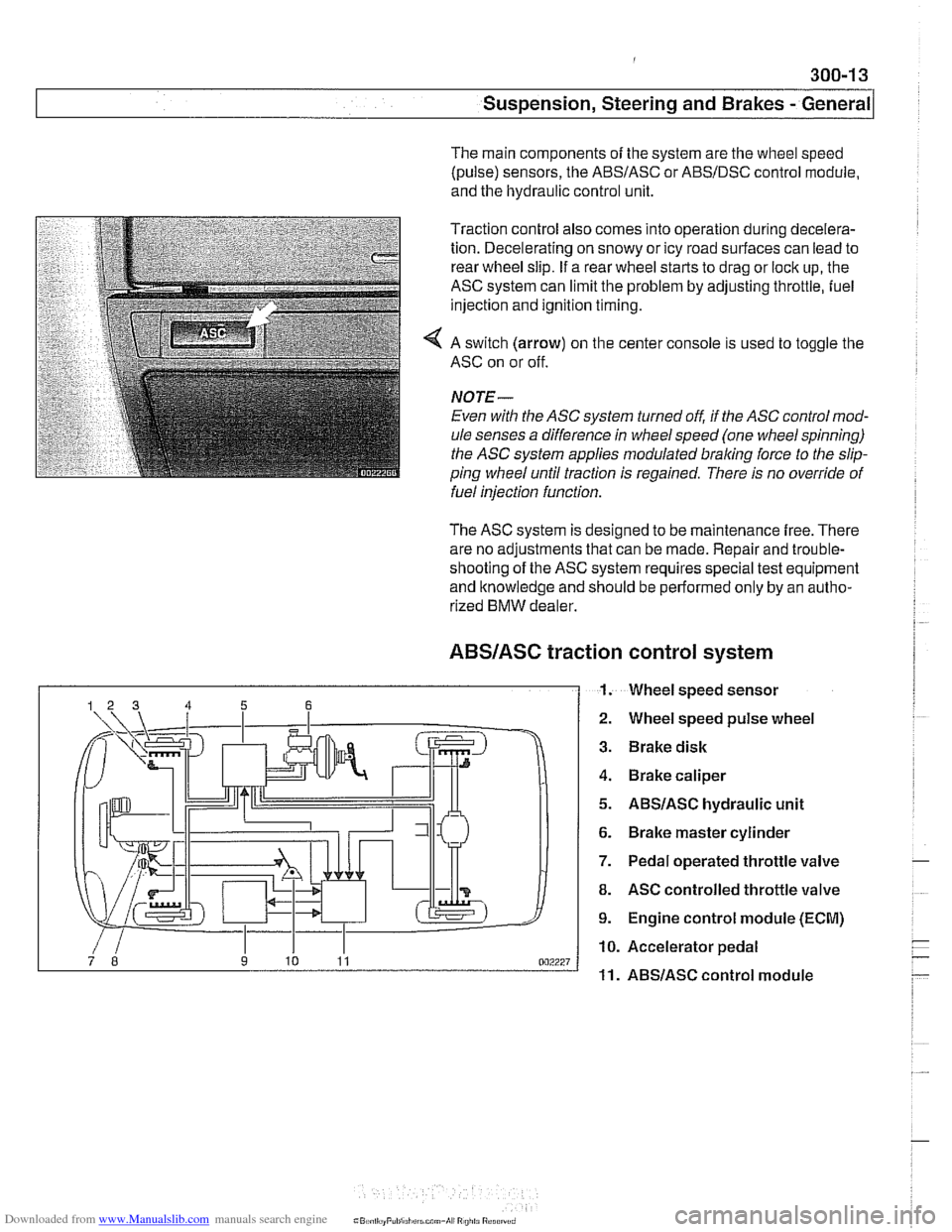
Downloaded from www.Manualslib.com manuals search engine
Suspension, Steering and Brakes - ~enerail
The main components of the system are the wheel speed
(pulse) sensors, the
ABSIASC or ABSIDSC control module,
and the hydraulic control unit.
Traction control also comes into operation during decelera-
tion. Decelerating on snowy or icy road surfaces can lead to
rear wheel slip. If a rear wheel starts to drag or lock up, the
ASC system can limit the problem by adjusting throttle, fuel
injection and ignition timing.
4 A switch (arrow) on the center console is used to toggle the
ASC on or off.
NOJE-
Even with the ASC system turned off, if the ASC control mod-
ule senses a difference in wheel speed (one wheel spinning)
the
ASC system applies modulated braling force to the slip-
ping wheel until traction is regained. There is no override of
fuelinjection function.
The ASC system is designed to be maintenance free. There
are no adjustments that can be made. Repair and trouble-
shooting of the ASC system requires special test equipment
and knowledge and should be performed only by an autho-
rized
BMW dealer.
ABSIASC traction
I 1.
control system
Wheel speed sensor
Wheel speed pulse wheel
Brake disk
Brake caliper
ABSIASC hydraulic unit
Brake master cylinder
Pedal operated throttle valve
ASC controlled throttle valve
Engine control module (ECM)
Accelerator pedal
ABSlASC control module
Page 635 of 1002
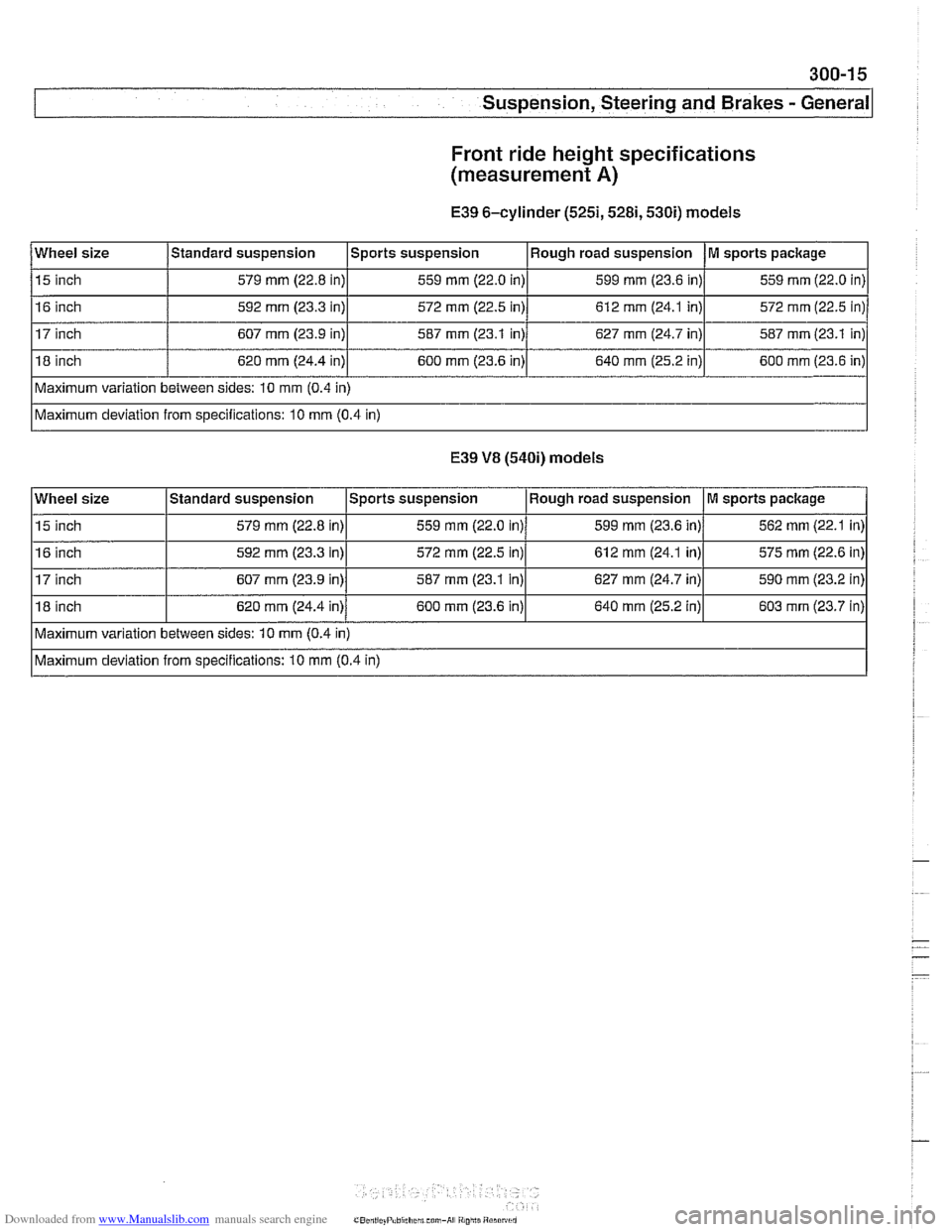
Downloaded from www.Manualslib.com manuals search engine
Suspension, Steering and Brakes - General
Front ride height specifications
(measurement
A)
E39 6-cylinder (5251,5281,530i) models
E39
V8 (540i) models
Wheel size
15 inch
16 inch
17 inch
18 inch
Maximum variation between sides: 10 mm (0.4 in)
Maximum deviation from specifications: 10 mm (0.4 in)
Standard
suspension
579 mm (22.8 in)
592 mm (23.3 in)
607 mm (23.9 in)
620 mm (24.4 in)
Wheel size
15 inch
16 inch
17 inch
18 inch Sports suspension
559
mm (22.0 in)
572 mm (22.5 in)
587 mm (23.1 in)
600 mm (23.6 in)
Maximum variation between sides: 10 mm (0.4 in)
Maximum deviation from specifications: 10 mm (0.4 in)
Standard
suspension
579 mm (22.8 in)
592
mm (23.3 in)
607 mm (23.9 in)
620 mm (24.4 in) Rough
road suspension
599
mm (23.6 in)
612 mm (24.1 in)
627 mm (24.7 in)
640 mm (25.2 in)
Sports suspension
559 mm (22.0 in)
572 mm (22.5 in)
587 mm (23.1 in)
600
mm (23.6 in)
M sports package
559 mm (22.0 in)
572 mm (22.5 in)
587 mm (23.1 in)
600 mm (23.6 in)
Rough road suspension 599 mm (23.6 in)
612
mm (24.1 in)
627
mm (24.7 in)
640
mm (25.2 in)
M sports package
562 mm (22.1 in)
575 mm (22.6 in)
590
mm (23.2 in)
603
mm (23.7 in)
Page 636 of 1002
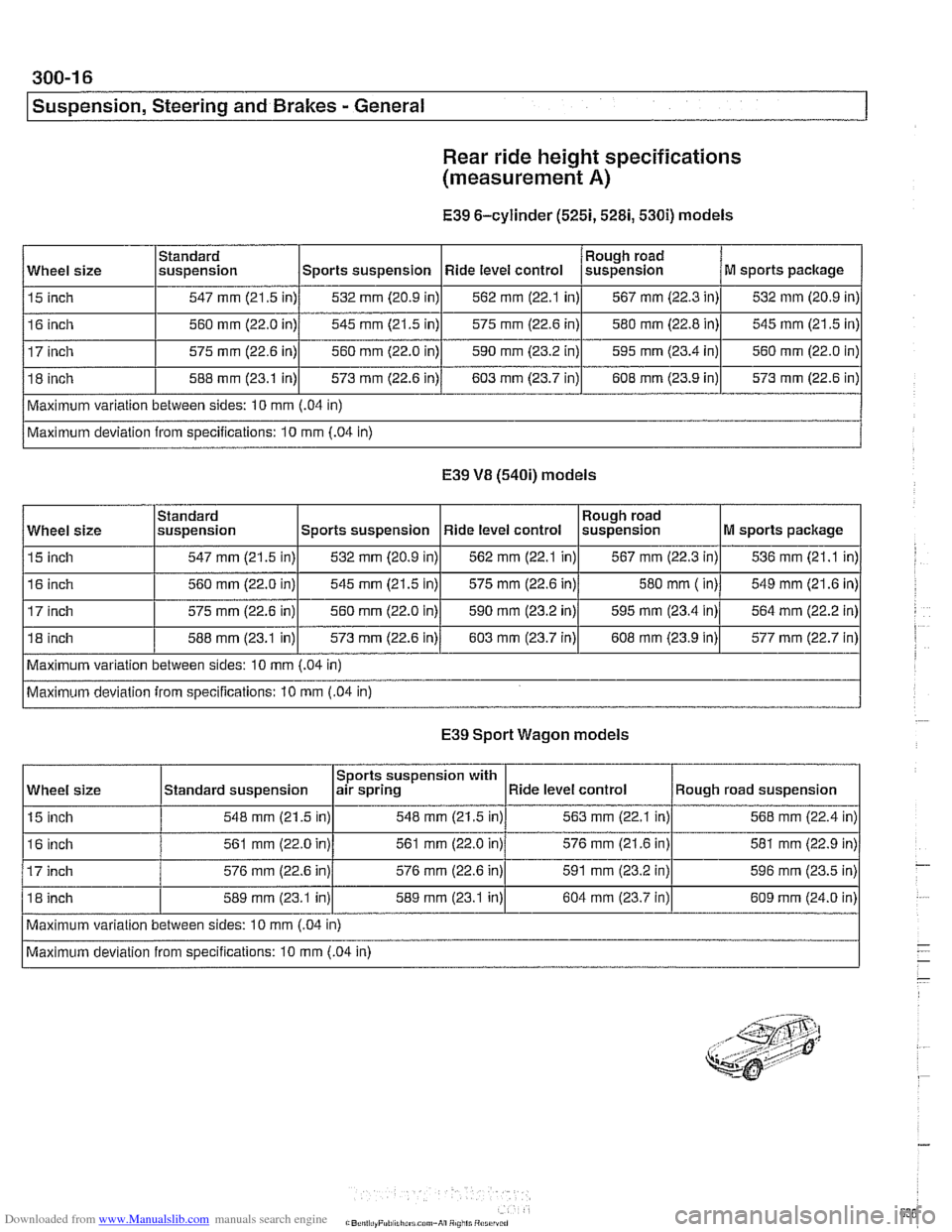
Downloaded from www.Manualslib.com manuals search engine
300-1 6
I Suspension, Steering and Brakes - General
Rear
ride height specifications
(measurement
A)
E39 6-cylinder (5251,5281,530i) models
E39 VB (540i) models
Wheel size
15 inch
16 inch
17 inch
18 inch
Maximum variation between sides: 10
mm (.04 in)
Maximum deviation from specifications: 10
mm (.04 in)
Standard
suspension
547 mm (21.5 in)
560
mm (22.0 in)
575 mm (22.6 in)
588 mm (23.1 in)
I I I I I
Maximum variation between sides: 10 mm (.04 in)
Wheel
size
15 inch
16 inch
575 mm (22.6 in)
Maximum deviation from specifications: 10 mm
(.04 in)
Sports suspension
532 mm (20.9 in)
545 mm (21.5 in)
560 mm (22.0 in)
573
mm (22.6 in)
Rough road
suspension
567
mm (22.3 in)
580 mm
( in)
E39 Sport Wagon models
M sports package
536
mm (21.1 in)
549 mm (21.6 in)
Standard
suspension
547 mm (21.5 in)
560 mm (22.0 in)
588 mm (23.1
in)l 573 mm (22.6 in)/ 603 mm (23.7 in)l 608 mm (23.9 in)l 577 mm (22.7 in)
560
mm (22.0
in) Ride level
control
562
mm (22.1 in)
575 mm (22.6 in)
590 mm (23.2 in)
603 mm (23.7 in)
Sports suspension 532
mm (20.9 in)
545 mm (21.5 in)
590
mm (23.2 in) Rough
road
suspension
567
mm (22.3 in)
580 mm (22.8 in)
595 mm (23.4 in)
608 mm (23.9 in)
Ride level control
562
mm (22.1 in)
575 mm (22.6 in)
Wheel size
15 inch
M sports package
532
mm (20.9 in)
545
mm (21.5 in)
560 mm (22.0 in)
573 mm (22.6 in)
595
mm (23.4 in)
Sports suspension with
air spring
548 mm (21.5 in)
Standard
suspension
548
mm (21.5 in)
16 inch
17 inch
18 inch 564
mm (22.2
in)
Maximum variation between sides: 10 mm
(.04 in)
Maximum deviation from specifications: 10 mm
(.04 in) 561
mm (22.0 in)
576
mm (22.6 in)
589
mrn (23.1 in)
561
mm (22.0 in)
576 mm (22.6 in)
589 mm (23.1 in) Ride level
control
563
mm (22.1 in) Rough road suspension
568 mm (22.4 in)
576 mm (21.6 in)
591 mm (23.2 in)
604 mm (23.7 in) 581
mm (22.9
in)
596
mm (23.5 in)
609 mm (24.0 in)